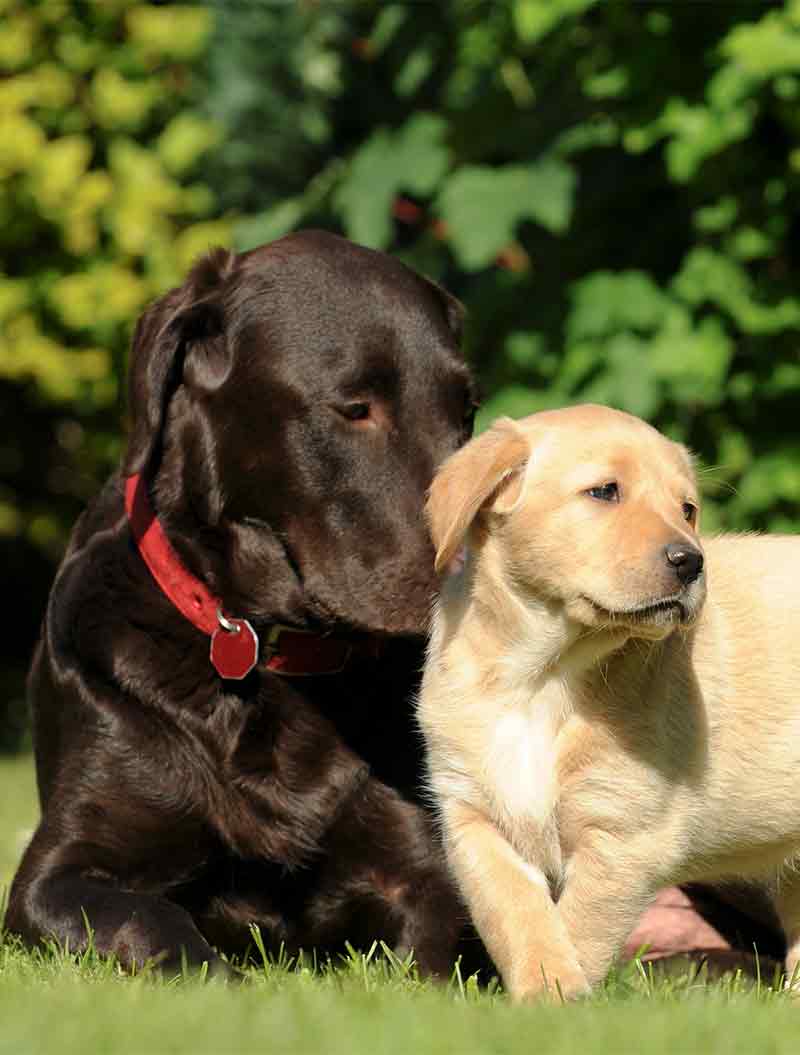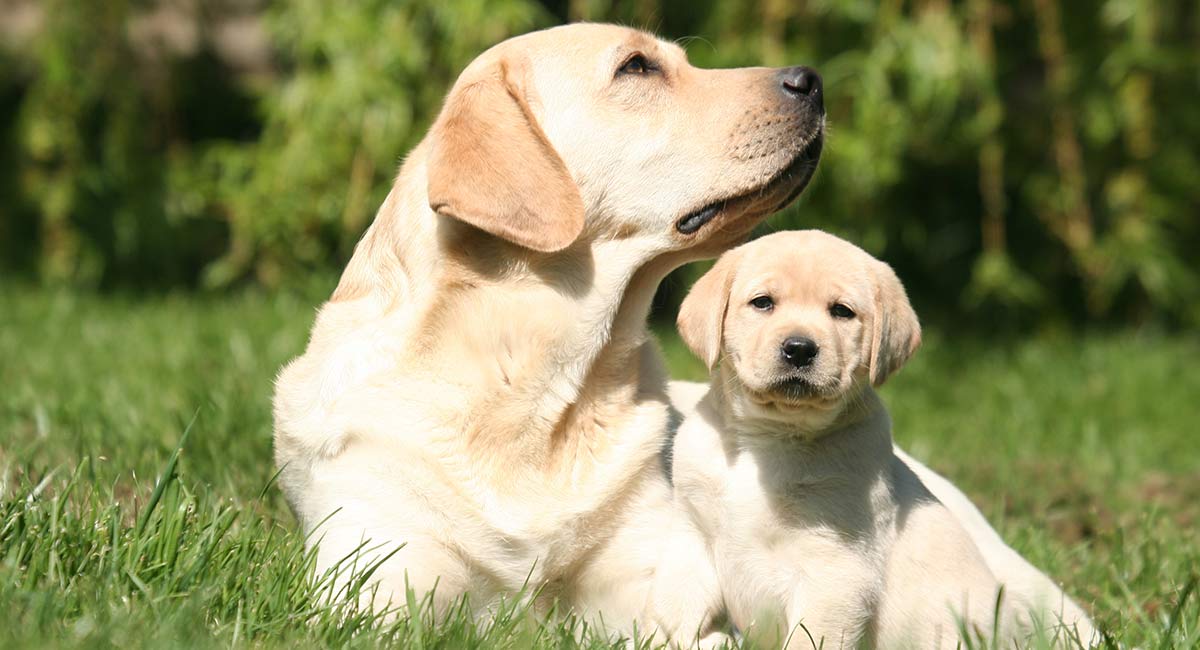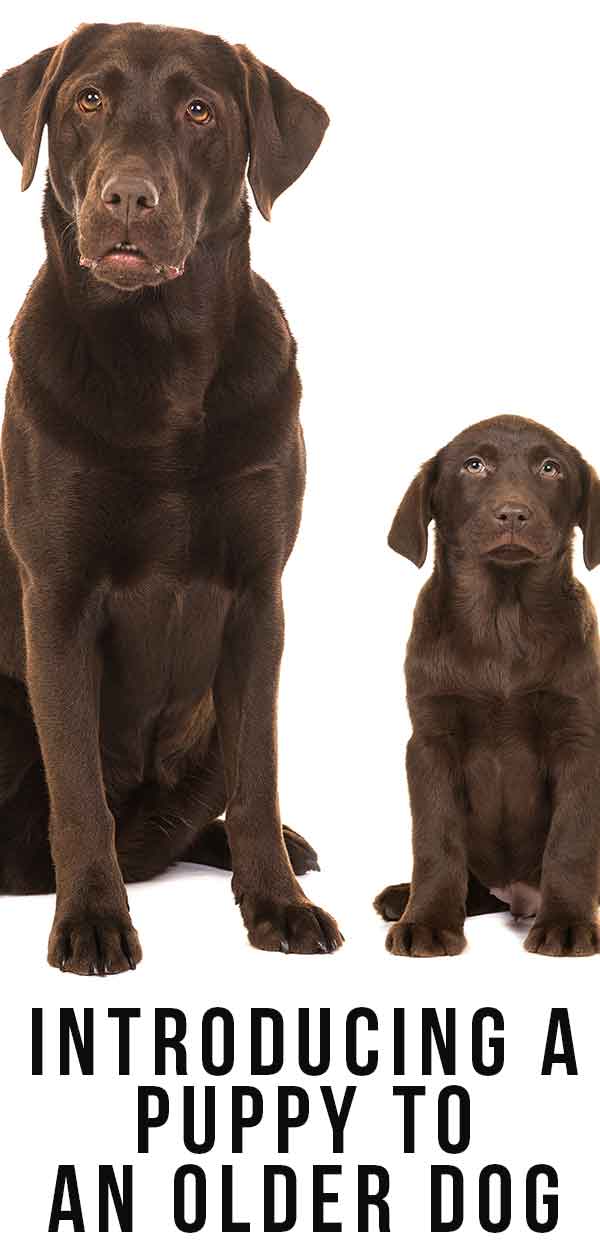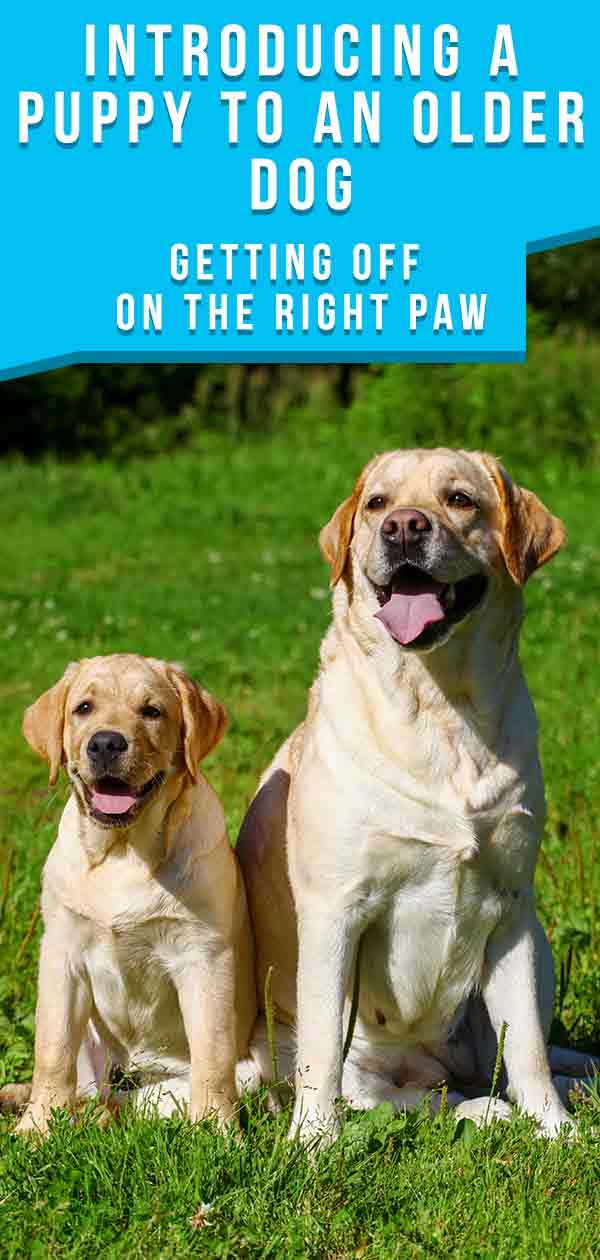Introducing A Puppy To An Older Dog – Getting Off On The Right Paw
Liz London is a certified dog trainer through the Certifying Council of Professional Dog Trainers (CPDT-KA) & the Karen Pryor Academy (Dog Trainer Foundations Certification) These are her top tips on when, where and how to introduce your new puppy to their future companion.
So puppy fever has struck again! And you want to know when to introduce your new puppy to your older dog. Most people tell me they want their older dog to meet the new puppy on the very first day, along with the rest of the family. And I am happy to tell you that’s okay provided you take some precautions.
Tips & Solutions
It’s important that both dogs are healthy and well, and especially that your older dog has all their vaccinations up to date. My view is that small puppies shouldn’t be in close contact with unvaccinated adult dogs until their own vaccinations are complete.
From a friendship point of view, there’s no magic trick to knowing the right time to introduce a new friend to the dog you’ve already had for a while. But there are some important precautions you can take to make the transition as smooth as possible. I am going to share some great strategies you can follow to ensure your dogs will be best friends forever!
Introducing a Puppy to an Older Dog
Introducing a puppy to an older dog is more likely to go smoothly if you set yourself up to succeed by following my top tips:
- Swap scents
- Use a Howdy crate
- Meet in a neutral area
- Take parallel walks
- Play training games
- Help adversaries become allies
Problems between your older dog and your new puppy are also less likely to arise if you use these additional ‘downtime’ strategies:
I explain all those options in more detail below (I have given you some links to skip to them if you want to) but first let’s just think ahead.
An Ounce of Prevention…
First things first, I want you to make sure that you are completely ready to introduce your new dog to his future friend, safely and calmly. In general, my best advice for introducing a new puppy to your current dog is this: PREVENTION, PREVENTION, PREVENTION! And a close runner up is SUPERVISION.
By thinking a few steps ahead of situations in which problems are most likely to arise, you can prevent a lot of the common difficulties of introducing a puppy to an older dog. As you follow my tips below, the biggest hurdle to overcome will be the difference between the characteristics and needs of your new puppy, and your older dog. In my experience, the high energy of a new puppy may be hard to balance against an older dog’s lower energy, preference for his old routine, or any past injuries or pain. This can make playtime between these dogs tricky to manage.
Supervision is vital in the first few weeks. I can’t stress that too much. You’ll soon become a bit of an expert at reading your older dog’s body language. When your older dog shows the signs for, “I’m tired” or, “Leave me alone!” you’re better off intervening to nip any potential fights in the bud. Be especially alert to your older dog growling, snarling or raising the fur on the back of his neck. These are signs that he has long since had enough! And it’s time for you to step in and separate them, or use up some of your puppy’s energy and enthusiasm in a structured way. If you need some help with that, you’ll find a link to Pippa’s online training courses below.
Tips for Introducing Your New Puppy And Current Dog
Swap Scents:
If you’re scheduling your new puppy pick-up in advance, and you already know which puppy you’re getting, you can ask the breeder, owner, or shelter manager for a piece of cloth that has been rubbed on the pup. I like to let my current dog smell it back at home to start making a mental map of the new family member coming his way, and I recommend you do this too.
Use a Howdy Crate:
A ‘howdy crate’ is a term zookeepers use when introducing a new animal into an exhibit with other animals for the first time. By putting the new animal in a crate in the exhibit, the animals can all say, “Howdy!” to one another through the safety of the crate walls. I use the same concept at home, and you’ll find that by putting your new puppy in a crate in the front yard or living room, your older dog can spend some time getting to know the new pup’s scent and sounds.
Neutral Territory Meet & Greets
I recommend that you introduce dogs to one another in a completely neutral area, like a park or a friend’s house. Make sure the space is fenced-in so that you can let both leashes drag loosely on the ground. If any problems come up, you can easily grab the end of the leash and separate the dogs safely.
It’s important the first time to have a second person around to help separate the dogs. And keep an eye on that body language! Stay relaxed and playful, while always gauging the situation.
Parallel Walks:
A great way to keep things moving is by going for a walk together. I use guided walks to reduce tension, anxiety, and fear in dogs. It also helps establish familiarity with other dogs in a natural canine social behavior. Both dogs are distracted from the introductions by physical activity and the sights, sounds, and scents of the world around them. Remember – it’s not safe for your puppy to be put on the ground in public places, until her vaccinations are complete. This is usually at around 16 weeks old. In the meantime she should not walk anywhere that any unvaccinated dogs could have access.

To do an effective parallel walk, two walkers each have one leashed dog. Throughout the walk, the walkers rotate through positions – the older dog could start in the lead, about 10 yards ahead of the puppy. Then after 10 minutes, the positions are reversed. After another 10 minutes, the dogs are brought side by side with only a yard or two of space between the now parallel-walking dogs. And don’t forget to stay relaxed, and avoid tension in the leash.
Training Games:
You can apply the same intent behind parallel walks to keep the dogs active and distracted from antagonizing each other by playing training games with both dogs near each other during early introductions. Instead of simply turning both dogs loose in the backyard and watching what happens, I run them through a series of simple cues and tricks.
For example, grab your treat pouch and your clicker (if you use one) and stand in the middle of the backyard, occasionally calling out a cue that your older dog knows. Sit, high five, turn in a circle, target your hand or a target pole, etc. Run through a few commands that will earn your dog some treats and distract him from the new dog.
Have a second handler working with the puppy, introducing some basic training games for puppies. Both dogs will be preoccupied, with intermittent sniff and greets in between mini sessions. I like to finish a short training sessions with a big burst of excitement and playtime with both dogs. Run around the yard together in a game of chase, romp, and roll! If you’d like help getting started with basic positive training for your puppy or your older dog, you might like to join one of our online training courses.
Notes on Training Games as Introductions
It’s worth noting that I usually have a hard time getting a dog to lie down when there are other, unfamiliar dogs around. My theory is that lying down creates canine body language associated with vulnerability and submission. In a situation with an unfamiliar dog nearby, my dog would rather ignore my training cues than put himself in a position of vulnerability.
It’s probably best to avoid asking for a lie down in this early parallel training session. You should also be very cautious of food-based aggression, as you give out treats. So if you notice either dog getting tense or aggressively stealing treats from the other, then end this game. If this happens you may need to consider working with a professional trainer on how to train two dogs at once without developing treat aggression.
Adversaries Become Allies:
Take both leashed dogs to unfamiliar territory for walks, such as a park or busy public place. The scents of other dogs will become the focus of their attention, and they will suddenly be allies against the world!
Tips on Avoiding Problems
The above activities are all great ways to help your older dog and your new puppy to bond. But they do all require active supervision and engagement from you. So what about when you aren’t able to play with, exercise, or train your dogs? Follow these top tips to avoid problems between your new arrival and his future friend.
Separate Corners (or Rooms)
If your house is a boxing ring, give each dog their separate corner. Crate them in separate rooms (or close the door to the room where puppy is crated) when they are not being supervised 100%. This is absolutely the simplest but most effective thing you can do when you are getting a puppy with an older dog already in the house.

Toy-Free Zone:
Put away all toys in the house for a few days to prevent a common form of aggression called resource guarding.
Supervised Chew Time:
If you want to give your dogs a bone or chewable treat each, great! Just make sure to offer each dog a treat, and be sure to separate them to opposite sides of the room. Remove whichever dog finishes first to avoid a fight.
Help – My Dog Hates My New Puppy
Ok, so you’ve followed the tips above for bringing a new puppy home with another dog waiting patiently back home. You’ve done neutral introductions and taken both dogs for walks together. You’ve played with them equally and tried some training games to show the dogs that they are a team. But you’re still having problems. I have some additional troubleshooting ideas if your new puppy and older dog are still not getting along.
Puppy and Older Dog Not Getting Along
How to deal with a new puppy and an older dog not getting along will depend on what your dogs are doing, and why.
Puppy Biting Older Dog
Biting and chewing on each other’s face is part and parcel of puppy play and getting to know other dogs. To a certain extent, I’m comfortable letting a puppy be a puppy for a few moments, nipping and snapping gently at the older dog to initiate play.
Either the older dog will give in to a bout of play, or he/she will snap at the puppy to let Pupper know, “I’m NOT in the mood, kid.” Since this is exactly how a mother dog would teach her puppies bite inhibition, I tend to let dogs speak their own language to one another to sort out mild differences.
If, however, the older dog becomes VERY aggressive and looks like he could really harm the pup, then by all means, intervene. You could do this by clapping loudly or calling one of the dogs over to you out of harm’s way, and crating him for a period of cooling down.
Puppy Annoying Older Dog
Even if the older dog isn’t aggressive with the pup, but the pup is relentless in his play biting, you’ll need to separate the dogs. Don’t give the older dog a chance to hit his threshold of patience. Give your puppy a chew toy that he can take his obsessive chewing behavior out on instead of your senior pooch’s ears. And give your older dog some space to recover and relax!
Older Dog Attacking New Puppy
If this is the case, you need to be a bit of a watch guard for your new pup. When the dogs are loose around each other, keep an eye on their body language. The minute you see what makes your older dog aggressive to puppy, step in.
When the older dog shows signs of arousal or tension, for example if you catch your dog growling at puppy, break things up. Use a cheerful voice to distract them, or a deep tone of voice calling, “HEY,” to disarm your older dog.
Be sure that both dogs have a space of their own to retreat to. The puppy needs a place to calm down when he gets overly aroused and gets too energetic or aggressive with you or your other dog. Your older dog needs a space of his own to have quiet, peace, and no nipping puppies chewing on his face.
Older Dog Jealous of New Puppy
It’s hard not to be anthropomorphic about our pets. Scientifically speaking, we shouldn’t impart our human emotions and ideas onto our pets. But if your older dog constantly steals toys away from your new puppy, growls if the puppy approaches when you are giving affection to the older dog, or gets more protective over his toys or your attention in general, it could seem like he is jealous of the new pooch in town.

Do your best to spend quality time with both dogs. Don’t abandon your one-on-one walks with your older dog. And do reward your older dog any time he approaches the new puppy nicely. Give him a treat and praise if the puppy comes near without any incident.
Remember that dogs probably do not share our understanding of possession, and puppy toys left lying around will seem like fair game to your older dog, so try to make sure that there are enough to go around.
Older Dog Depressed By The New Puppy
If your older dog seems to have less energy, be less playful, spend more time away from you and in the other rooms of the house, or hide in corners or under furniture, he may be more than just a little jealous. He might be full-on depressed at the changes in the household routine. Dogs really benefit from routine and structure, so the sooner you can get the whole household back into a routine that resembles what your older dog was habituated to, the better his mental state will be.


Free Labrador Updates!
Get my training tips, news, reviews, and the latest from The Labrador Site delivered to your inbox



I’m devastated- I introduced a young female jack Russell puppy to my 8 yr old female only child a few times before bringing home and things seemed to be going well. Then when the puppy moved in the older dog was not as accepting and seemed to get depressed ( was also recently diagnosed with a chronic illness) I did everything the books say. Lavished attention on older dog and walked them together. Played separately and together and for the most part kept the baby segregated in the kitchen where I spent most my time. It wasn’t long and the puppy had bonded a lot with me and in the evening when I tried to hold my older dog the puppy would not sit in my husbands lap or play with him… she just stared at me and older dog either whining and occasionally growling and then bolting over causing my older dog to get update and bail out leaving her looking at me, “ like really mom… your taking puppy over me” I tried crating the puppy when I wanted time with older dog but the puppy didn’t understand why she was in there and whined to be a part of attention. I gave it a month and my husband said it was too stressful for the older dog and basically told me to rehome her. I did and now I am miserable and miss her so much! Can’t help thinking of her and if more time would have helped. She is so smart and sweet but didn’t want my older dog to feel betrayed even though I gave her special attention also. The new owner has already blown off the free puppy lessons I paid for and the vet appt I had. I’m so sad :/
And funny, cover of her book isn’t a lab at all. It’s a X lab
Anyone who thinks labs should be walked on a leash shouldn’t own a lab. That’s not what they are. They’re working dogs. They don’t *have* to work but leashes? Good god, no.
What an amazing, detailed article.
Thanks, Pippa!
I have two female GSD one is 10 and one is 9. We are getting a male GSD puppy in a couple weeks. I am a bit nervous because my girls do not like other dogs. We recently lost one GSd and my 10 year old has cancer and not wanting the 9 year old to be olone. A couple months ago we got a kitten and they did fine. Are puppies easier to introduce than dogs? Or because of the dislike of other dogs should I be worried?
My older dog is more scared of the puppy. When the puppy jumps or nips at the older dog, she either freezes or tries to run away. I love them both. I want them to be friend and I would love for all of us to shared time together instead of me spitting my time between the two. Help!!
Just stumbled across this. I have a 10 year old lab and our new lab puppy has been home with us for 3 weeks. Our old guy seems so scared of the puppy and it’s so upsetting. Curious how your pups turned out?
When can we reintroduce toys?? Once they get along?
Hi we brought our puppy home yesterday,
And have crated him the the living room where our older dog has access to but sleeps under the stairs. Our older dog can get funny with other dog when we are out on walks, if I keep things moving she is normally quite good. We have put a gate between the kitchen and hall way where the older dog sleeps so we can let the puppy roam safely. But I am unsure when to let them both free in the same room. So the puppy can get very close. The older dog got a little inqusertive and came over when I had the pup on a lease then had a growl. Just feeling a little unsure if keeping them segregated to long not be good
My gsd is 11yrs old, he has been fantastic with a whole range of family/babies and children and pets that have lived with us all, puppies birds,cats kittens un neutered male dog female dogs…we have introduced him to our new member of our house,she is a female 8 week old Doberman pup, Kane instantly took a very bad liking to her and has attacked her more than twice..badly..and for no reason apart from her puppies ways she is extremely obedient for her age and knows not to push playing too much,he seems to corner her and attack within split second when out of eye sight with me, like if we walk into house from garden he will turn on her or when following me in,or when she walks past him…I’m getting him vet checked but lost all trust when he then growled right up to my child’s face which has never happened before and after mailing the puppies three times now causing injury…Please what help or guidness is there to offer as I have tried a lot so far with bad results.i really home someone can help as I love my dogs they are my best friends.
Yes, do get your older dog checked out by a vet. Maybe he is in pain. Growling at children is of great concern. Next step is he will bite. Good luck and hope you have a good outcome. Andrew